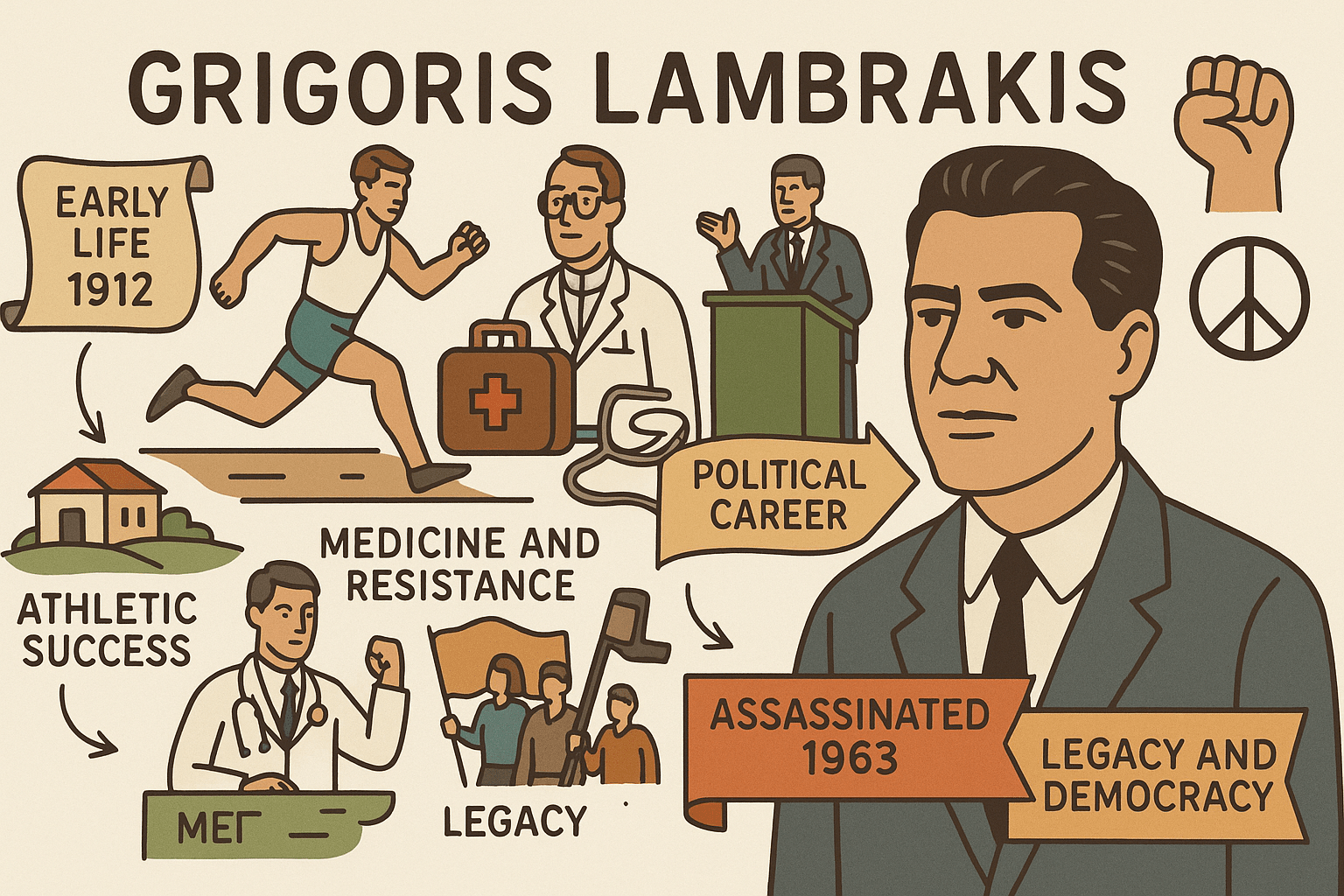
Grigoris Lambrakis was more than a politician or doctor—he was a man who turned peace into a mission and social justice into a calling. His life, marked by athletic triumphs, academic excellence, and fearless activism, remains a cornerstone of modern Greek democratic ideals. The Grigoris Lambrakis peace legacy echoes far beyond the moment of his tragic assassination in 1963; it continues to inspire movements, spark debates, and remind people of the power of conscience over violence.
A Humble Beginning in Arcadia
Lambrakis was born in 1912 in the small village of Kerasitsa in the Peloponnese. Growing up in rural Greece, his early years were shaped by hardship and limited means. Yet, what he lacked in resources, he made up for with resolve. From a young age, he showed an unusual drive—both mentally and physically—which would later define his life’s path.
Athletics: A Platform for Peace
Before entering the world of politics or medicine, Lambrakis rose to prominence as a national athlete. He specialized in the long jump and triple jump, setting a Greek record that remained unbroken for over two decades. Representing Greece in various Balkan competitions and the 1936 Berlin Olympics, he wasn’t just competing—he was fostering unity through sport. These moments of cross-cultural respect laid the early foundations of the Grigoris Lambrakis peace legacy.
Medicine, Education, and Compassionate Practice
Following his athletic career, Lambrakis studied medicine and eventually became a lecturer at the University of Athens. His focus was obstetrics and gynecology, and he gained respect not only for his academic contributions but also for his humane approach to patient care. He operated a private clinic, where he treated poor and working-class patients at no cost. This moral choice wasn’t about charity—it was about justice, and it revealed a man unwilling to let privilege override his principles.
Resistance During the Nazi Occupation
During the brutal years of Nazi occupation in Greece (1941–1944), Lambrakis refused to stay silent. While many professionals kept a low profile, he joined the resistance. In 1943, he co-founded the Union of Greek Athletes, a group that organized sporting events to raise food and aid for starving citizens. It was a peaceful form of resistance, consistent with what would later define the Grigoris Lambrakis peace legacy: using nonviolence as a weapon against tyranny.
Political Awakening and Rising Influence
After the war, Lambrakis was elected to the Greek Parliament in 1961 as an independent leftist aligned with the United Democratic Left. Though not a member of the Communist Party, he was seen as a unifying figure for progressive forces in Greece. He quickly became one of the few voices in Parliament willing to challenge militarism, state-sponsored violence, and foreign interference.
He also served as Vice President of the Greek Commission for International Détente and Peace (EDYE), traveling across Europe to promote disarmament and nuclear non-proliferation. His bold speeches often landed him in trouble with conservative authorities, but they also cemented his role as a true peace advocate.
The Solo March That Stirred a Nation
On April 21, 1963, Lambrakis took part in a peace march from Marathon to Athens—a protest the police had banned. While dozens of participants were detained or prevented from marching, Lambrakis used his parliamentary immunity to walk alone, carrying a banner with a peace symbol. That solitary march made headlines across Europe and became a defining moment in the Grigoris Lambrakis peace legacy. His courage showed that even one person standing alone could challenge an unjust system.
The Assassination That Sparked a Movement
Only a month later, on May 22, 1963, Lambrakis delivered a passionate speech at a peace rally in Thessaloniki. As he exited the venue, a three-wheeled vehicle sped toward him. Two right-wing extremists struck him in the head, gravely injuring him. He died five days later, at the age of 51.
The killing shocked the nation. Despite official efforts to frame it as an isolated act, public outcry revealed deeper state collusion with extremist forces. Over half a million Greeks attended his funeral, turning it into one of the largest protests in the country’s history.
A Legacy That Refused to Die
Rather than silencing him, Lambrakis’ death ignited a new wave of activism. The Lambrakis Democratic Youth was founded in his name, led by famous composer Mikis Theodorakis. The group championed social reforms and kept Lambrakis’ vision alive through art, education, and civic engagement.
His story also inspired the iconic political thriller Z by Vassilis Vassilikos, which was adapted into an award-winning film by Costa-Gavras. The movie turned Lambrakis into a symbol of global resistance against authoritarianism, and the letter “Z”—standing for “He lives”—became a rallying cry.
Recognition and Ongoing Impact
Although the Greek military junta later banned all mention of Lambrakis, democracy’s return in 1974 restored his memory. Streets, schools, and institutions now bear his name. In 2013, the Greek Parliament officially honored his contributions. His story has also been celebrated internationally by peace organizations like the International Peace Bureau, which posthumously recognized his role in the fight for global disarmament.
His influence continues through modern peace campaigns, including the International Campaign to Abolish Nuclear Weapons (ICAN), which builds upon the same ideals Lambrakis died defending.
Why His Legacy Still Matters
In a world torn by wars, political repression, and social inequality, the Grigoris Lambrakis peace legacy is a call to action. It proves that moral clarity and personal integrity can be more powerful than violence. Lambrakis didn’t just speak about peace—he lived it, walked for it, and ultimately died for it. His legacy urges each generation to confront injustice not with hatred, but with courage and compassion.
FAQ Section
Q1: Who was Grigoris Lambrakis?
A: A Greek athlete, doctor, politician, and peace activist who was assassinated in 1963 for his outspoken stance against militarism and injustice.
Q2: What is the Grigoris Lambrakis peace legacy?
A: It refers to his lifelong commitment to nonviolence, democratic reform, and global disarmament. His activism inspired major social and political changes in Greece.
Q3: Why was he assassinated?
A: He was murdered by far-right extremists linked to the state, who saw his growing influence as a threat to their authoritarian control.
Q4: How is Lambrakis honored today?
A: Through memorials, public events, educational institutions, and international peace initiatives that continue the work he began.
Q5: What can modern activists learn from him?
A: Lambrakis taught that lasting change often comes through peaceful resistance, moral courage, and a commitment to truth, even in the face of danger.z





